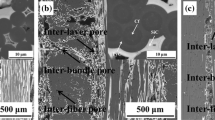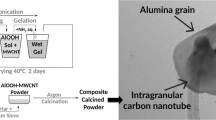Abstract
A novel anti-ablation material of carbon/carbon (C/C) composites modified with the carbides of zirconium-titanium was prepared by reacted melt infiltration (RMI) and their synthetic mechanism and microstructure were investigated. Carbon fiber felts were firstly densified by carbon using chemical vapor infiltration to obtain a porous C/C skeleton. The zirconium-titanium melt was then infiltrated into the porous C/C skeleton at high temperatures to obtain the final composites. Models based on these results were built up to describe the diffusion behavior of carbon atoms in the carbides and the kinetic process of RMI. The results also show that the synthesized composites have good interface cohesion between carbon fibers, pyrocarbon and carbide. The carbide with high content of Zr atom in the final composites is composed of the main phase of Zr0.83Ti0.17C0.92, dispersively distributed with the phase of Ti0.82Zr0.18C0.92, while the carbide with high content of Ti composed of Zr0.57Ti0.43C1.01.
Access this chapter
Tax calculation will be finalised at checkout
Purchases are for personal use only
Preview
Unable to display preview. Download preview PDF.
Similar content being viewed by others
References
E. Fitzer, “Future of carbon–carbon composites,” Carbon, 25(2) (1987), 163–253.
C. Blanco et al, “Influence of fibre matrix interface on the fracture behavior of carbon–carbon composites,” J Eur Ceram Soc, 23(15) (2003), 2857–2923.
J.E. Sheehan, “Oxidation protection for carbon fiber composites, Carbon, 27(1989),709–715.
W.G. Fahrenholtz and G.E. Hilmas, “Future ultrahigh temperature materials” (UHTM workshop draft report NSF-AFOSR joint workshop on future, ultra-high temperature materials, 2004)
Y Zeng et al., “Microstructure and ablation behavior of carbon/carbon composites infiltrated with Zr-Ti,” Carbon, 54(2013),300–309.
YG, Tong et al., “C/C–SiC composite prepared by Si–10Zr alloyed melt infiltration,” Ceram. Int., 38(4) (2012), 3301–3307.
L.M. Adelsberg, L.H. Cadoff, and J.M. Tobin, “Kinetics of the Zirconium-carbon reaction at temperatures above 2000°C,” Trans.Met.Soc.AIME, (236) (1966), 972–977.
J Yang and O.J. Ilegbusi, “Kinetics of silicon–metal alloy infiltration into porous carbon,” Composites: Part A, 31 (2000), 617–625.
YG Wang et al., “Reaction kinetics and ablation properties of C/C–ZrC composites fabricated by reactive melt infiltration,” Ceram. Int., 37 (2011), 1277–1283.
J.A.V. Butler, “The thermodynamics of the surfaces of solutions,” Proc. R. Soc. A, 135(1932),348–75.
E.A Brandes and G.B. Brook, Smithhells metals reference book (London, Butterworth Heinemann, 1992),146–1410.
B.J. Keene. “Review of data for the surface tension of pure metals,” Int Mater Rev, 38(4)(1993),157–249.
E.A. Guggenheim, “Statistical thermodynamics of the surface of a regular solution,” Trans. Faraday. Soc., 41(1945),150–156.
E.T. Turkdogan, Physical chemistry of high temperature technology (New York, Academic Press, 1980), 90–93.
D.J. Steinberg, “A simple relationship between the temperature dependence of the density of liquid metals and their boiling temperatues,” Met.Trans, 5(1974),1341.
B.C. Allen, “The surface tension of liquid transition metals at their melting points,” Trans.Met.Soc. AIME, 227(1963), 1175.
B.C. Allen, Liquid metals:chemistry and physics,(New York, Marcel Dekker, 1972)161–183.
T.Iida, M.Ueda, and Z.I. Morita, “On the excess viscosity of liquid alloys and the atomic interaction of their constituents,” Tetse-to-Hagane, 62(9)(1976),1169–1247.
A.V. Grosse, “The temperature range of liquid metals and an estimate of their critical constants,” J. lnorg.Nucl.Chem, 23(1961),333.
T. Iida And R.I.L. Guthrie, The physical properties of liquid metals, (London, Oxford University Press, 1993) 103–220.
L. Pauling, The Nature of the Chemical Bond (3rd Edn.), (Ithaca, NY: Cornell University Press, 1960), 644.
A.Mortensen and T.Wong, “Infiltration of fibrous preforms by a pure metal: part III. capillary phenomena,” Met. Trans. A, (21) A (1990), 2257–2263.
Y. waseda, The structure of non-crystalline materials:liquids and amorphous solids. (New York, McGraw-Hill, 1980)49–59.
O.M. Barabash and Yu.N. Koval, “Crystal Structure of Metals and Alloys,” Naukova Dumka, Kiev, USSR (in Russian), (1986),215–216.
D. Bandyopadhyay, R.C. Sharma, and N. Chakraborti, “The C-Ti-Zr System (Carbon-Titanium-Zirconium),” J. Phase Equilibria, 22(1)(2001),61–64.
K.C. Hari Kumar, P. Wollants, and L. Delaey, “Thermodynamic assessment of the Ti-Zr system and calculation of the Nb-Ti-Zr phase diagram,” J. Alloy Compounds, 206 (1)(1994), 121–127.
L.H. Zou, et al, “Microstructural development of a Cf/ZrC composite manufactured by reactive melt infiltration,” J. Eur. Ceram. Soc. 30(2010),1527–1535.
Author information
Authors and Affiliations
Editor information
Editors and Affiliations
Rights and permissions
Copyright information
© 2013 TMS (The Minerals, Metals & Materials Society)
About this paper
Cite this paper
Zeng, Y., **ong, X., Li, G., Chen, Z., Sun, W., Wang, D. (2013). Preparation and Microstructure of Carbon/Carbon Composites Modified with Zr-Ti-C Fabricated by Reacted Melt Infiltration. In: Marquis, F. (eds) Proceedings of the 8th Pacific Rim International Congress on Advanced Materials and Processing. Springer, Cham. https://doi.org/10.1007/978-3-319-48764-9_54
Download citation
DOI: https://doi.org/10.1007/978-3-319-48764-9_54
Publisher Name: Springer, Cham
Print ISBN: 978-3-319-48586-7
Online ISBN: 978-3-319-48764-9
eBook Packages: Chemistry and Materials ScienceChemistry and Material Science (R0)




